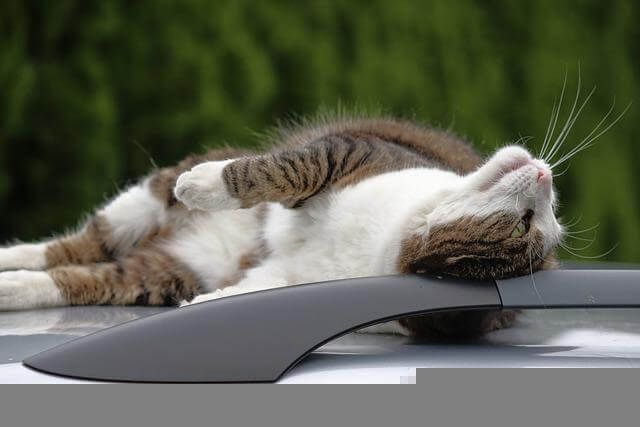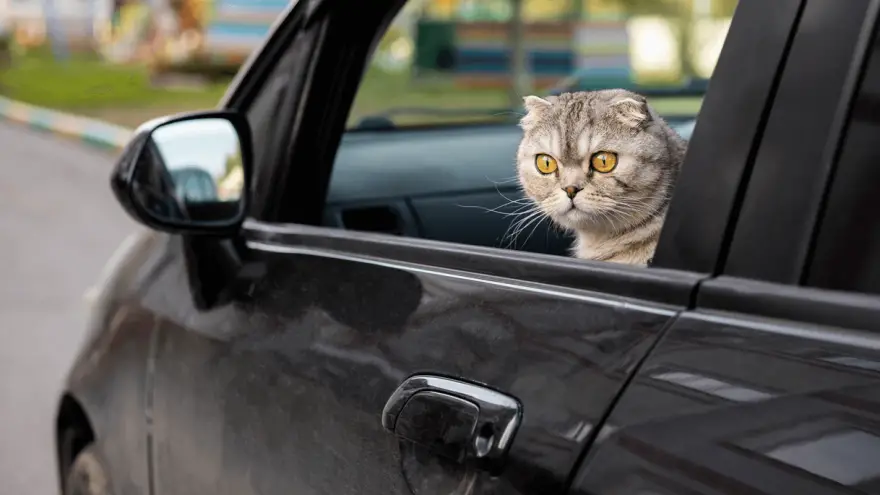8 Helpful Tips For Safe Traveling With Your Cat
15.05.2022.
Whether you're taking your cat to the vet or boarding them at a cattery, you want the experience to be as stress-free as possible for you and your cat. Here's what you should know about traveling with cats in a car and staying safe.
1. Carrier
Cats and kittens should be transported in a carrier for their own safety. In the event of an accident, a pet becomes a hairy projectile. A cat in your lap or under the pedals can distract the driver, who should be focused on the road and traffic. Regardless of how well-behaved your cat is, an airbag can crush it if the cat is in the front seat during an accident. Because of this, crate training before the actual trip is essential.
RELATED: How To Teach a Cat To Walk On a Leash? 3 Easy Steps
2. Exploration
Allow your cat to sniff and explore the car, so take them in and close the door. Watch out for kittens that might try to squeeze into the crevices under the car's dashboard. Five-minute explorations are all that is necessary. As soon as they start acting scared, get them back into a non-scary place. Raised fur, flat ears, moving tail, or vocalizations are all signs that a cat is in distress. To keep the kitty calm, practice these five-minute car visits several times for a couple of days.
3. Time to prepare
Your cat should get a feel of the car, even though they will typically be confined to a crate. As a result of their environmental sensitivity and sense of territory, cats prefer to spend their time in places they are familiar with. You can make the car feel more like home by allowing your feline friend to spread their scent around, and they'll feel more at ease and happy while traveling.
4. Car mealtime
Food is your ally when you're getting your kitten used to the car. Once they calm down, feed them their meals inside the vehicle. You can also give them special treats they only get during car visits. If your cat prefers to play or a "dose" of catnip to get them going, give them some of their favorite toys while you're driving. You should give them this special treat when they're near the car. Make sure your cat associates your car with something they adore.
RELATED: How To Train Your Cat: Expert Tips & Tricks
5. Adapting the car environment
Put the cat's bed, towel, or blanket with your cat's scent on the vehicle's back seat. It's the best way for your cat to already feel at home. Feliway Comfort Zone can also be sprayed on a towel or the car's upholstery to help the cat relax.

6. Establish a routine
The crate training and car visits should be combined. The cat's carrier should be placed in the back of the car, away from airbag danger, once they've accepted the car as their home. Afterward, start the engine without going anywhere. Make this process a part of your cat's daily routine by repeating it 3-5 times a day. Once they're out of the crate, give them loads of praise, treats, or other rewards.
7. Start driving
Then, after you've started the vehicle and your cat is used to spending time in the car, it's time to start moving. Start by driving in your driveway or your street. After each trial, let the cat out. A crying or stressed-out cat may indicate that you're moving too quickly through the process. Keep in mind - this is a long process, but it's proven and effective.
RELATED: Cat Repellents: How To Keep Cats Away From Restricted Areas
8. Increase your driving time
Make minor, incremental improvements to the time spent in the car. An excellent way to increase driving time is to try driving the same route twice instead of driving around the block and back home. Make every car ride a positive experience for the cat, so they are excited about the next trip.

Additional tips
Once you learn how the driving process goes and how you can make your feline companion feel comfortable during a trip, you should start looking at other details that will make this a pleasant experience for all parties. Here are a few additional tips regarding the safety and comfort of cats in cars.
Want to know which carriers are the best? Check them out here - 7 Best Cat Carriers For Safe Travels.
Type of carrier
If your cat is traveling in a carrier, they must be safe and comfortable. The absolute best carriers have the following characteristics:
Material
Plastic cat carriers are the safest and most comfortable for your pet to travel in. In contrast, wire mesh carriers are more difficult for your pet to get out of. It is also easier to clean plastic carriers.
Size
The cat carrier must be long and tall enough so your cat can comfortably lie, stand, sit, and move around. It's possible that you'll need an extra-large carrier if you have a large cat breed at home, like a Maine Coon.

Exit points
Some cats prefer to be lowered into the carrier through a roof-mounted door, while others prefer to enter the carrier through a door. This feature is especially beneficial if your cat goes into the carrier free willingly. With both options, you can select the best way for your cat based on their unique needs and preferences.
RELATED: 5 Tips On How To Bathe A Cat Safely
Removable top part
If a cat is apprehensive and refuses to exit the carrier, this can be a lifesaver at the vet's office. The cat can stay in the bottom part of the carrier while the top is removed, allowing for a thorough examination without disturbing the cat.
Privacy and concealment options
Plastic carriers with slits in the back and sides for ventilation are the most likely choice for this purpose. These slits can also be used to give your cat treats while they're inside.
Space at the bottom
When traveling in the carrier, the smell inside the carrier should remind your cat of their home. It's an easy way to make them feel safe and secure. That is why it is crucial the carrier has plenty of space at the bottom for your cat's bed or blanket.
What are the best methods for carrying a carrier?
You want to make sure your cat is comfortable and safe inside the carrier. If the carrier can move around or is placed at a weird angle, your kitten will likely feel unbalanced and even injure themselves.
RELATED: How Often Should I Take My Cat to the Vet?
You should carry the carrier with both arms. One arm should hold the top and the other on the bottom. That will allow you to hold it close to you – especially if it is pretty heavy once you place your cat inside it. When you're done moving, always put the carrier down on a stable, evenly-leveled surface.

Cat owner traveling tips
All cat owners agreed traveling with a cat that is not in a carrier is not safe. Since we believe a practical approach is the best, we gathered the best practical advice from experienced cat owners. Here are the tips they gave us;
- If you can, spray the vehicle with Feliway Classic 15 minutes prior to traveling with your cat.
- It is best to remove car air fresheners and thoroughly ventilate the vehicle before your cat enters, as cats have a highly developed sense of smell.
- The car and home temperature should be about the same, so your cat will be more at ease.
- Place your cat in the carrier and use the seat belt to secure it in place by passing it through the handle of the carrier. This is the only way to keep your cat's carrier safe and secure if a car accident.
RELATED: Expert Opinion - Why Do Cats Lick Me?
- A rolled-up towel under the carrier is a practical way to ensure the carrier is level and stable since most cars have sloped seats.
- Make your cat's carrier private and less likely for it to be bothered by noises outside by using a towel, sheet, or a blanket to cover it.
- In the car, avoid loud music and noises. However, classical music played at a low volume can help to mask the sounds of the outside world, such as traffic, from being heard.
- During the trip, if your cat doesn't get car sick and loves food, you can give them little treats through the carrier's slits periodically to distract and occupy them.
- Throughout the journey, you can speak to your cat in a friendly, calm, and reassuring tone of voice.
- To make the trip as comfortable as possible for your cat, avoid taking sharp turns, accelerating quickly, or braking suddenly while driving.
- If your cat becomes agitated or ill while riding in the car, you should consult your veterinarian to see if they can offer any solutions.
- Choose less congested times of day for traveling with your cat and avoid making unnecessary stops to keep the trip short.
World Cat Finder Team







Share